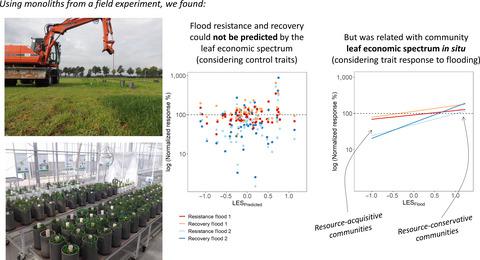当前位置:
X-MOL 学术
›
J. Appl. Ecol.
›
论文详情
Our official English website, www.x-mol.net, welcomes your feedback! (Note: you will need to create a separate account there.)
Plant community flood resilience in intensively managed grasslands and the role of the plant economic spectrum
Journal of Applied Ecology ( IF 5.7 ) Pub Date : 2020-06-08 , DOI: 10.1111/1365-2664.13667 Natalie J. Oram 1 , Gerlinde B. De Deyn 1 , Paul L. E. Bodelier 2 , Johannes H. C. Cornelissen 3 , Jan Willem Groenigen 1 , Diego Abalos 1, 4
Journal of Applied Ecology ( IF 5.7 ) Pub Date : 2020-06-08 , DOI: 10.1111/1365-2664.13667 Natalie J. Oram 1 , Gerlinde B. De Deyn 1 , Paul L. E. Bodelier 2 , Johannes H. C. Cornelissen 3 , Jan Willem Groenigen 1 , Diego Abalos 1, 4
Affiliation

|
The increasing frequency of extreme weather events, such as floods, requires management strategies that promote resilience of grassland productivity. Mixtures of plant species may better resist and recover from flooding than monocultures, as they could combine species with stress-coping and resource acquisition traits. This has not yet been tested in intensively managed grasslands despite its relevance for enhancing agroecosystem resilience. Using intact soil cores from an 18-month-old field experiment, we tested how 11 plant communities (Festuca arundinacea, Lolium perenne, Poa trivialis and Trifolium repens in monoculture, two- and four-species mixtures) resist and recover from repeated flooding in a 4-month greenhouse experiment. We found that plant community composition, not whether the community was a mixture or monoculture, influenced the community's resistance to flooding, although most communities were able to resist and recover from both floods. The plant community's position on the leaf economic spectrum in flooded conditions was related to its resistance to and recovery from flooding. Resistance to and recovery from a severe flood were related to flood-induced intraspecific trait variation, causing a shift in the community's position on the leaf resource economic spectrum. In flooded conditions, resource-conservative communities (characterized by low specific leaf area, low leaf nitrogen content and high leaf dry matter content) better resisted and recovered from flooding. The community's position on the root resource economic spectrum was less connected to the community's resistance and recovery. Synthesis and applications. Our study shows that in flooded conditions, resource-conservative plant communities are more resilient to flooding than resource-acquisitive communities in an intensively managed grassland. This suggests that plant community position on the leaf economic spectrum, as well as species’ flood-induced intraspecific variation, should be considered when designing grasslands to withstand increasing flood frequency and severity.
中文翻译:

集约化管理草地的植物群落抗洪能力和植物经济谱的作用
极端天气事件(如洪水)的频率越来越高,需要采取管理策略来提高草原生产力的恢复能力。植物物种的混合可能比单一栽培更好地抵抗洪水和从洪水中恢复,因为它们可以将物种与压力应对和资源获取特征结合起来。尽管这与增强农业生态系统的复原力有关,但尚未在集约化管理的草地上进行测试。我们使用来自 18 个月大田间试验的完整土壤核心,测试了 11 种植物群落(单株栽培中的羊茅、黑麦草、早熟禾和白三叶草、两种和四种混合物)如何抵抗和恢复重复洪水为期 4 个月的温室实验。我们发现植物群落组成,而不是群落是混合栽培还是单一栽培,影响了社区对洪水的抵抗力,尽管大多数社区都能够抵抗两次洪水并从中恢复。植物群落在洪水条件下叶片经济谱上的位置与其对洪水的抵抗力和恢复能力有关。对严重洪水的抵抗和恢复与洪水引起的种内性状变异有关,导致群落在叶片资源经济谱上的位置发生变化。在洪水条件下,资源节约型群落(以低比叶面积、低叶氮含量和高叶干物质含量为特征)更好地抵抗洪水并从洪水中恢复。社区在根资源经济谱上的立场与社区的抵抗和恢复联系较少。合成与应用。我们的研究表明,在洪水条件下,资源节约型植物群落比集约化管理草地中的资源获取型群落更能抵御洪水。这表明在设计草地以承受不断增加的洪水频率和严重程度时,应考虑植物群落在叶片经济谱上的位置以及物种的洪水引起的种内变异。
更新日期:2020-06-08
中文翻译:

集约化管理草地的植物群落抗洪能力和植物经济谱的作用
极端天气事件(如洪水)的频率越来越高,需要采取管理策略来提高草原生产力的恢复能力。植物物种的混合可能比单一栽培更好地抵抗洪水和从洪水中恢复,因为它们可以将物种与压力应对和资源获取特征结合起来。尽管这与增强农业生态系统的复原力有关,但尚未在集约化管理的草地上进行测试。我们使用来自 18 个月大田间试验的完整土壤核心,测试了 11 种植物群落(单株栽培中的羊茅、黑麦草、早熟禾和白三叶草、两种和四种混合物)如何抵抗和恢复重复洪水为期 4 个月的温室实验。我们发现植物群落组成,而不是群落是混合栽培还是单一栽培,影响了社区对洪水的抵抗力,尽管大多数社区都能够抵抗两次洪水并从中恢复。植物群落在洪水条件下叶片经济谱上的位置与其对洪水的抵抗力和恢复能力有关。对严重洪水的抵抗和恢复与洪水引起的种内性状变异有关,导致群落在叶片资源经济谱上的位置发生变化。在洪水条件下,资源节约型群落(以低比叶面积、低叶氮含量和高叶干物质含量为特征)更好地抵抗洪水并从洪水中恢复。社区在根资源经济谱上的立场与社区的抵抗和恢复联系较少。合成与应用。我们的研究表明,在洪水条件下,资源节约型植物群落比集约化管理草地中的资源获取型群落更能抵御洪水。这表明在设计草地以承受不断增加的洪水频率和严重程度时,应考虑植物群落在叶片经济谱上的位置以及物种的洪水引起的种内变异。



























 京公网安备 11010802027423号
京公网安备 11010802027423号